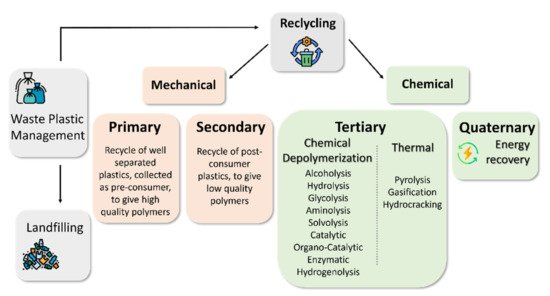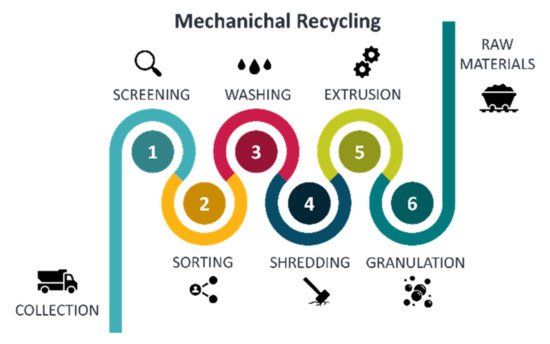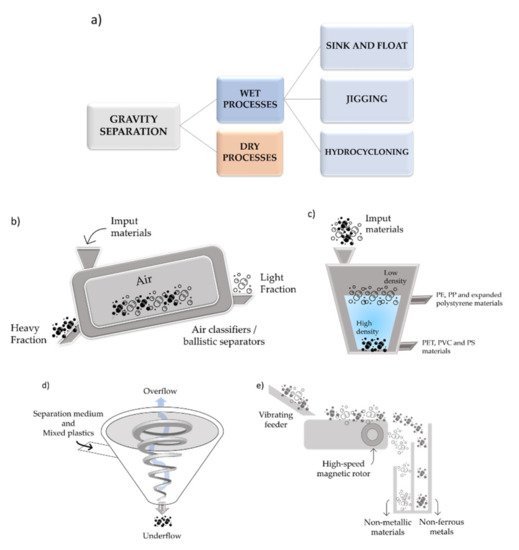
| Version | Summary | Created by | Modification | Content Size | Created at | Operation |
|---|---|---|---|---|---|---|
| 1 | Valentina Beghetto | + 2409 word(s) | 2409 | 2021-09-05 09:29:15 | | | |
| 2 | Jessie Wu | Meta information modification | 2409 | 2021-09-16 03:32:43 | | |
Video Upload Options
Today, the scientific community is facing crucial challenges in delivering a healthier world for future generations. Among these, the quest for circular and sustainable approaches for plastic recycling is one of the most demanding for several reasons. Indeed, the massive use of plastic materials over the last century has generated large amounts of long-lasting waste, which, for much time, has not been object of adequate recovery and disposal politics. Most of this waste is generated by packaging materials. Nevertheless, in the last decade, a new trend imposed by environmental concerns brought this topic under the magnifying glass, as testified by the increasing number of related publications. Several methods have been proposed for the recycling of polymeric plastic materials based on chemical or mechanical methods. A panorama of the most promising studies related to the recycling of polyethylene (PE), polypropylene (PP), polyethylene terephthalate (PET), and polystyrene (PS) is given within this review.
1. Introduction
2. Overview of Plastic Recycling Techniques

3. Primary and Secondary Recycling


References
- Leal Filho, W.; Saari, U.; Fedoruk, M.; Iital, A.; Moora, H.; Klöga, M.; Voronova, V. An overview of the problems posed by plastic products and the role of extended producer responsibility in europe. J. Clean. Prod. 2019, 214, 550–558.
- Rasmussen, S.C. From parkesine to celluloid: The birth of organic plastics. Angew. Chem. Int. Ed. 2021, 60, 8012–8016.
- Chalmin, P. The history of plastics: From the capitol to the tarpeian rock. FACTS 2019, 19, 6–11.
- Geyer, R.; Jambeck, J.R.; Law, K.L. Production, use, and fate of all plastics ever made. Sci. Adv. 2017, 3, 1–5.
- Gilbert, M. Plastics materials: Introduction and historical development. In Brydson’s Plastics Materials, 8th ed.; Elsevier Inc.: Amsterdam, The Netherlands, 2016; pp. 2–18.
- Scalenghe, R. Resource or waste? A perspective of plastics degradation in soil with a focus on end–of–life options. Heliyon 2018, 4, 1–39.
- Paletta, A.; Leal Filho, W.; Balogun, A.L.; Foschi, E.; Bonoli, A. Barriers and challenges to plastics valorisation in the context of a circular economy: Case studies from italy. J. Clean. Prod. 2019, 241, 118149–118164.
- Foschi, E.; Bonoli, A. The commitment of packaging industry in the framework of the european strategy for plastics in a circular economy. Adm. Sci. 2019, 9, 18.
- Idumah, C.I.; Nwuzor, I.C. Novel trends in plastic waste management. SN Appl. Sci. 2019, 1, 1402–1416.
- Kumar, R. Tertiary and Quaternary Recycling of Thermoplastics by Additive Manufacturing Approach for Thermal Sustainability. Mater. Today Proc. 2020, 37, 2382–2386.
- Gopinath, K.P.; Nagarajan, V.M.; Krishnan, A.; Malolan, R. A critical review on the influence of energy, environmental and economic factors on various processes used to handle and recycle plastic wastes: Development of a comprehensive index. J. Clean. Prod. 2020, 274, 123031–123047.
- Davidson, M.G.; Furlong, R.A.; McManus, M.C. Developments in the life cycle assessment of chemical recycling of plastic waste–A review. J. Clean. Prod. 2021, 293, 126163–126175.
- Thiounn, T.; Smith, R.C. Advances and approaches for chemical recycling of plastic waste. J. Polym. Sci. 2020, 58, 1347–1364.
- Brouwer, M.T.; Thoden van Velzen, E.U.; Augustinus, A.; Soethoudt, H.; de Meester, S.; Ragaert, K. Predictive model for the dutch post–consumer plastic packaging recycling system and implications for the circular economy. Waste Manag. 2018, 71, 62–85.
- Antonopoulos, I.; Faraca, G.; Tonini, D. Recycling of post-consumer plastic packaging waste in eu: Process efficiencies, material flows, and barriers. Waste Manag. 2021, 126, 694–705.
- Ncube, L.K.; Ude, A.U.; Ogunmuyiwa, E.N.; Zulkifli, R.; Beas, I.N. An overview of plastic waste generation and management in food packaging industries. Recycling 2021, 6, 12.
- Chen, X.; Wang, Y.; Zhang, L. Recent progress in the chemical upcycling of plastic wastes. ChemSusChem 2021, 14, 1–16.
- Chen, H.; Wan, K.; Zhang, Y.; Wang, Y. Waste to wealth: Chemical recycling and chemical upcycling of waste plastics for a great future. ChemSusChem 2021, 14, 1–15.
- Schyns, Z.O.G.; Shaver, M.P. Mechanical recycling of packaging plastics: A review. Macromol. Rapid Commun. 2021, 42, 2000415.
- Mulakkal, M.C.; Castillo Castillo, A.; Taylor, A.C.; Blackman, B.R.K.; Balint, D.S.; Pimenta, S.; Charalambides, M.N. Advancing mechanical recycling of multilayer plastics through finite element modelling and environmental policy. Resour. Conserv. Recy. 2021, 166, 105371.
- Ellen Mac Arthur Foundation. The New Plastics Economy: Rethinking the Future of Plastics & Catalysing Action; Ellen Mac Arthur Foundation: Cowes, UK, 2016.
- Lange, J.-P. Towards circular carbo-chemicals–the metamorphosis of petrochemicals. Energy Environ. Sci. 2021, 14, 4358–4376.
- Rahimi, A.R.; Garciá, J.M. Chemical recycling of waste plastics for new materials production. Nat. Rev. Chem. 2017, 1–11.
- Serranti, S.; Bonifazi, G. Techniques for separation of plastic wastes. In Use of Recycled Plastics in Eco-efficient Concrete; Elsevier: Amsterdam, The Netherlands, 2019; pp. 9–37.
- Das, S.K.; Eshkalak, S.K.; Chinnappan, A.; Ghosh, R.; Jayathilaka, W.A.D.M.; Baskar, C.; Ramakrishna, S. Plastic recycling of polyethylene terephthalate (PET) and polyhydroxybutyrate (PHB)—A comprehensive review. Mater. Circ. Econ. 2021, 3, 1–22.
- Larrain, M.; van Passel, S.; Thomassen, G.; van Gorp, B.; Nhu, T.T.; Huysveld, S.; van Geem, K.M.; de Meester, S.; Billen, P. Techno–economic assessment of mechanical recycling of challenging post–consumer plastic packaging waste. Resour. Conserv. Recy. 2021, 170, 105607–105620.
- Na, H.; Yoo, K.; Jha, M.K.; Tabelin, C.B. The separation of aluminum and stainless-steel scraps using vibrating mixed-size ball bed. Metals 2020, 10, 868.
- Selina, M.; Markus, B.; Daniel, S.; Renato, S. Wet-mechanical processing of a plastic-rich two-dimensional-fraction from mixed wastes for chemical recycling. Waste Manag. Res. 2021, 39, 731–743.
- Schwabl, D.; Bauer, M.; Lehner, M. Advancing plastic recycling by wet-mechanical processing of mixed waste fractions. Processes 2021, 9, 493.
- Civancik-Uslu, D.; Nhu, T.T.; van Gorp, B.; Kresovic, U.; Larrain, M.; Billen, P.; Ragaert, K.; de Meester, S.; Dewulf, J.; Huysveld, S. Moving from Linear to Circular Household Plastic packaging in belgium: Prospective life cycle assessment of mechanical and thermochemical recycling. Resour. Conserv. Recy. 2021, 171, 105633.
- Zhang, Y.; Jiang, H.; Du, Y.; Wang, C.; Wang, H. Surface alcoholysis induced by alkali-activation ethanol: A novel scheme for binary flotation of polyethylene terephthalate from other plastics. J. Clean. Prod. 2021, 314, 128096.
- Heidarpour, M.; Movahed, S.O.; Jourabchi, S. The effect of microwave irradiation on the flotation of the selected polymers as a potential solution for plastic recycling. J. Polym. Environ. 2021, 1–15.
- Tanısalı, E.; Özer, M.; Burat, F. Precious metals recovery from waste printed circuit boards by gravity separation and leaching. Min. Proc. Extr. Met. Rev. 2020, 24–37.
- Bilesan, M.R.; Makarova, I.; Wickman, B.; Repo, E. Efficient separation of precious metals from computer waste printed circuit boards by hydrocyclone and dilution-gravity methods. J. Clean. Prod. 2021, 286, 125505.
- Huang, Z.; Zhu, J.; Wu, X.; Qiu, R.; Xu, Z.; Ruan, J. Eddy current separation can be used in separation of non-ferrous particles from crushed waste printed circuit boards. J. Clean. Prod. 2021, 312, 127755.
- Nie, C.C.; Shi, S.X.; Lyu, X.J.; Wu, P.; Wang, J.X.; Zhu, X. Settlement behavior and stratification of waste printed circuit boards particles in gravitational field. Resour. Conserv. Recy. 2021, 170, 105615.
- Araujo-Andrade, C.; Bugnicourt, E.; Philippet, L.; Rodriguez-Turienzo, L.; Nettleton, D.; Hoffmann, L.; Schlummer, M. Review on the photonic techniques suitable for automatic monitoring of the composition of multi-materials wastes in view of their posterior recycling. Waste Manag. Res. 2021, 39, 631–651.
- Duan, Q.; Li, J. Classification of common household plastic wastes combining multiple methods based on near-infrared spectroscopy. ACS ES&T Eng. 2021, 7, 1065–1073.
- Thoden van Velzen, E.U.; Chu, S.; Alvarado Chacon, F.; Brouwer, M.T.; Molenveld, K. The impact of impurities on the mechanical properties of recycled polyethylene. Packag. Technol. Sci. 2021, 34, 219–228.
- Cacciari, I.; Corradi, G. Common plastics THz classification via artificial neural networks: A discussion on a class of time domain features. Opt. Mater. 2021, 117, 111134.
- Zeng, Q.; Sirven, J.B.; Gabriel, J.C.P.; Tay, C.Y.; Lee, J.M. Laser induced breakdown spectroscopy for plastic analysis. Trac-Trend. Anal. Chem. 2021, 140, 16280.
- Bobulski, J.; Kubanek, M. Deep learning for plastic waste classification system. Appl. Comput. Intell. Soft Comput. 2021, 1, 3–4.
- Knappich, F.; Klotz, M.; Schlummer, M.; Wölling, J.; Mäurer, A. Recycling process for carbon fiber reinforced plastics with polyamide 6, polyurethane and epoxy matrix by gentle solvent treatment. Waste Manag. 2019, 85, 73–81.
- Georgiopoulou, I.; Pappa, G.D.; Vouyiouka, S.N.; Magoulas, K. Recycling of post-consumer multilayer tetra pak® packaging with the selective dissolution-precipitation process. Resouer. Conserv. Recy. 2021, 165, 105268.
- Sherwood, J. Closed-Loop Recycling of Polymers Using Solvents. Johns. Matthey Technol. Rev. 2020, 64, 4–15.
- Vollmer, I.; Jenks, M.J.F.; Roelands, M.C.P.; White, R.J.; van Harmelen, T.; de Wild, P.; van der Laan, G.P.; Meirer, F.; Keurentjes, J.T.F.; Weckhuysen, B.M. Beyond mechanical recycling: Giving new life to plastic waste. Angew. Chem. Int. Ed. 2020, 59, 15402–15423.
- Wang, S.; Ma, S.; Qiu, J.; Tian, A.; Li, Q.; Xu, X.; Wang, B.; Lu, N.; Liu, Y.; Zhu, J. Upcycling of post-consumer polyolefin plastics to covalent adaptable networksvia in situcontinuous extrusion cross-linking. Green Chem. 2021, 23, 2931–2937.
- Roosen, M.; Mys, N.; Kusenberg, M.; Billen, P.; Dumoulin, A.; Dewulf, J.; van Geem, K.M.; Ragaert, K.; De Meester, S. Detailed analysis of the composition of selected plastic packaging waste products and its implications for mechanical and thermochemical recycling. Environ. Sci. Technol. 2020, 54, 13282–13293.
- Eriksen, M.K.; Christiansen, J.D.; Daugaard, A.E.; Astrup, T.F. Closing the loop for pet, pe and pp waste from households: Influence of material properties and product design for plastic recycling. J. Waste Manag. 2019, 96, 75–85.
- Korley, L.T.J.; Epps, T.H.; Helms, B.A.; Ryan, A.J. Toward polymer upcycling-adding value and tackling circularity. Science 2021, 373, 66–69.




